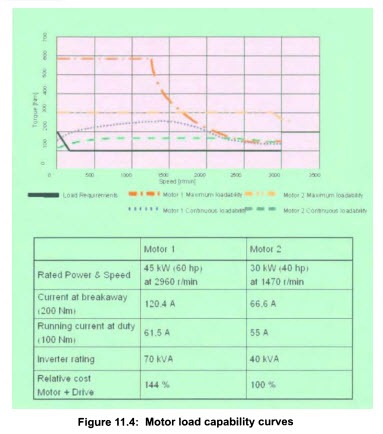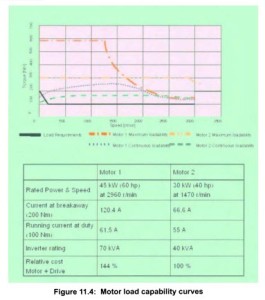Operating motors above base speed
In some instances operating a motor beyond base frequency is possible if the consequences are carefully examined as shown in the following example.
If a PD pump requires 200 Nm torque to breakaway, and 100 Nm torque in the operating range from 500 r/min to 3000 r/min pump speed, i.e. around 31 kW absorbed power at maximum speed, it is possible to select
a two pole motor, which will run in the constant flux area. An illustration of the above is shown in Figure 11.4.
A typical 37 kW 400 V two pole 50 Hz self ventilated motor will run outside of its thermal capabilities below 1500 r/min, so a 45 kW motor would normally be selected. (This is substantially less costly than fitting a fixed speed fan to the 37 kW option .)
The 45 kW motor draws around 62 Amps when delivering 100 Nm at 3000 r/min, but will require around 120 A to develop 200 Nm at breakaway.
An alternative selection is to use a 37 kW four pole motor with a normal synchronous speed of 1500 r/min, at which it is capable of running at 37 kW at 50 Hz 400 V delivering 240 Nm and drawing 70 A.
This motor will also operate at 400 V, 100 Hz, (3000 r/min), delivering 100 Nm, while drawing around 55 A. A current of around 65 A is required to develop 200 Nm at breakaway.
This means that the converter current required for the two pole solution is double that required for the four pole solution. A substantially smaller and cheaper converter can therefore be used with the four pole motor.
This enables a lower rated drive to be used, while still ensuring satisfac torily control the pump/motor over its desired duty range.
There are a number of points that also need to be taken into account when considering such solutions:
• Noise will be increased with speed.
• Bearing life or greasing intervals may be reduced, or improved fit bearings may be required.
• In extreme cases the higher speed may be beyond the maximum rotational speed of the motor, or a critical speed may occur within the operating range.
• Another important point that also needs to be considered when using a motor with lower base speed to deliver high starting torque, is whether the torque required at full speed can de provided by the motor, because not only does its rated torque fall inversely with frequency but the break down torque falls inversely with the square of frequency, either of which can be the restricting parameter.

